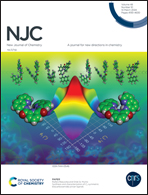Preparation of a silver ferrite-assisted tungsten oxide nanocomposite for efficient sonocatalytic degradation of organic pollutants activated by PMS followed by toxicity evaluation†
Abstract
Sonocatalytic technology combined with ultrasonic irradiation with a variety of semiconductors has attracted much attention to address environmental issues. In this work, a silver ferrite (AgFeO2)-modified tungsten oxide (WO3) composite was used as a sonocatalyst for the removal of organic pollutants. The use of peroxymonosulfate (PMS) in the degradation process increases the sonocatalytic efficiency. AFO, WO3, and AFO/WO3 composites were prepared via a simple hydrothermal process. The prepared materials were characterized by various analytical techniques such as X-ray diffraction (XRD), Fourier transform-infrared (FT-IR) spectroscopy, UV-visible-DRS (UV-Vis DRS), scanning electron microscopy (SEM), energy-dispersive X-ray spectroscopy (EDS), Raman spectroscopy, transmission electron microscopy (TEM), and X-ray photoelectron spectroscopy (XPS). The AFO/WO3 composite material shows excellent degradation activity and stability during the sonocatalytic process. The sonocatalytic efficiency of the prepared material against organic pollutants such as rhodamine B (RhB), malachite green (Mal.G), and a mixed dye effluent were 96%, 95%, and 70%, respectively. The nature of the degraded water was investigated by plant survival studies, which confirmed that the treated water was much suitable for the survival of plants.


 Please wait while we load your content...
Please wait while we load your content...